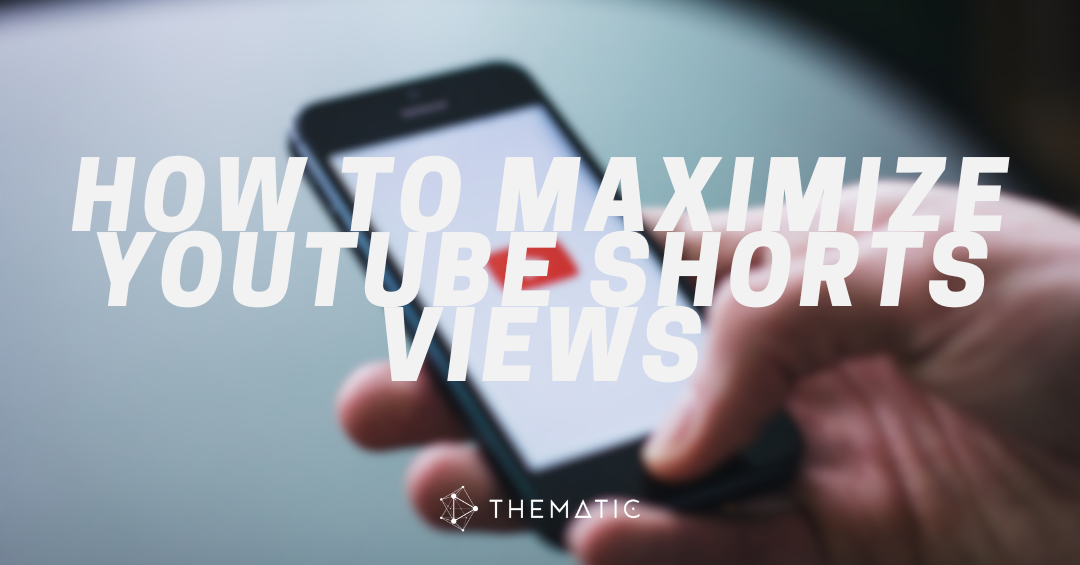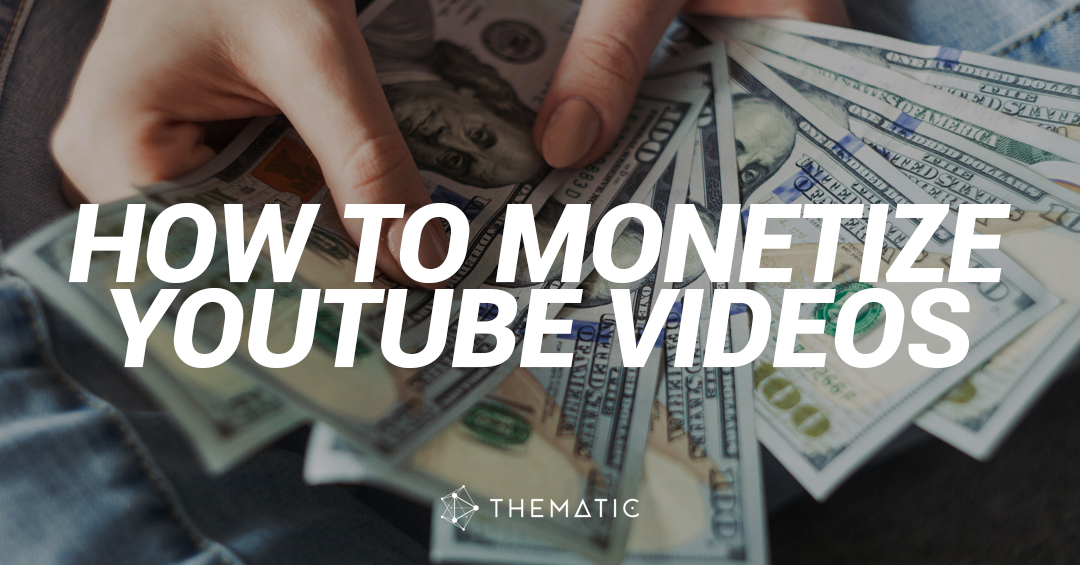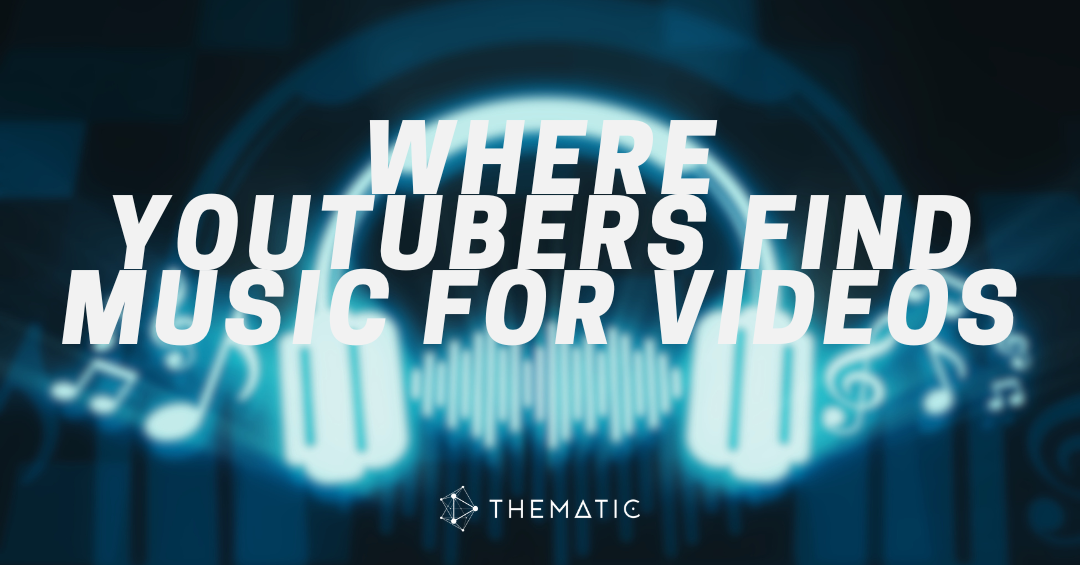Getting a copyright claim on your YouTube video can feel confusing or even a little alarming, but it’s more common than you might think. In this step-by-step guide to copyright claims on YouTube, we’ll walk you through what a copyright claim actually means, how claims can impact your video and YouTUbe channel, and the different options you have to remove the claim and prevent your videos from getting flagged moving in the future ✅
Use our Table of Contents to jump directly to the section you want to explore:
- Understanding Copyright Claims
- How Copyright Claims Impact Your Channel and Videos
- How to Fix a Copyright Claim
- How to Avoid Copyright Claims
Understanding Copyright Claims
Navigating copyright on YouTube can feel overwhelming, especially when you receive a claim on your video. Before diving into the details, it’s important to understand what a copyright claim actually means, how it affects your content, and how it differs from a more serious copyright strike.
This section will walk you through the basics so you can confidently manage and respond to any copyright issues that arise.
What is a YouTube copyright claim?
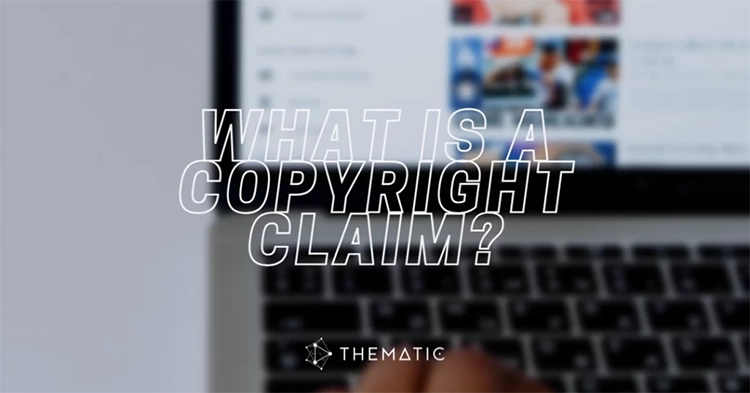
A copyright claim on YouTube means that your video includes copyrighted content (like music, video clips, or images) that belongs to someone else.
Every single video on YouTube is scanned for copyright. YouTube does this through their automated system called Content ID, which scans all videos uploaded to YouTube against their database of copyrighted works. When Content ID detects a copyright match on a video, it automatically puts a copyright claim on the video and alerts the owner of the copyright, who can choose what to do the to video (such as monetize it with ads, track the video’s analytics, or block it from being viewed).
Not all copyright claims are bad news and receiving a copyright claim doesn’t mean you’re in trouble, but it’s important to understand what is being claimed and why it happened.
The purpose of copyright claims on YouTube is to make sure that copyrighted works are protected and valued. The owners of the copyrighted content have invested their time and money into making the song or video and they have the right to decide how and when their content is used by others. YouTube Content ID simply allows copyright holders to protect and manage their copyrighted content across YouTube.
Think about it – if you took time to create a really awesome video or song, wouldn’t you want the option to control how and where other people can use it?
What happens when my video gets a copyright claim?
If your video receives a copyright claim, you may receive an email from YouTube that looks like this:
[YouTube] A copyright claim was created for content in “Your Video Title”
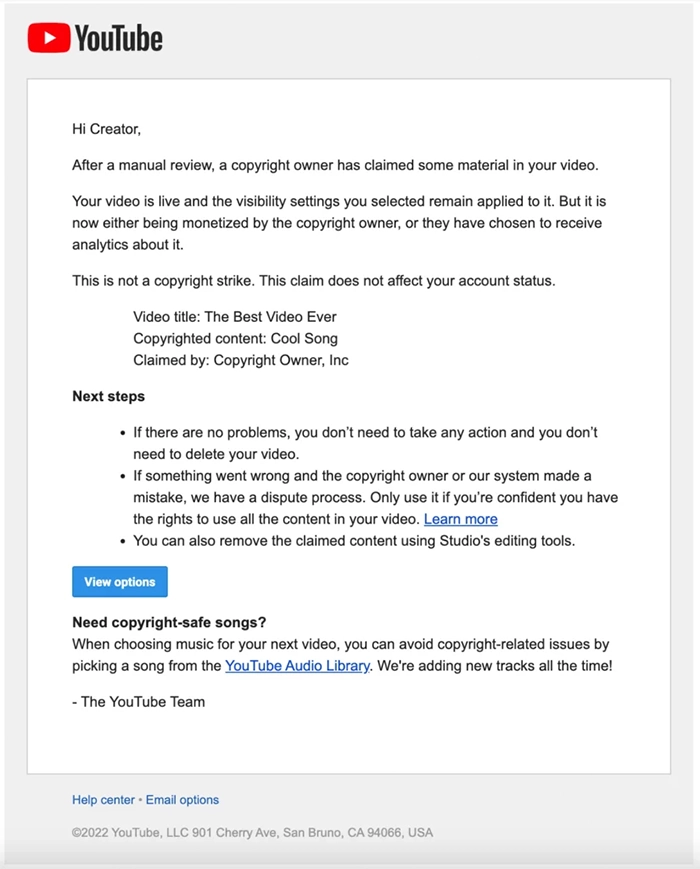
You will also notice the word copyright showing next to your video in your YouTube Studio dashboard (or Copyright+1 if multiple claims are on the video).
Click the word Copyright to get more details about the copyright claim and information about who made the claim, what copyrighted work was detected, and where it plays in your video.
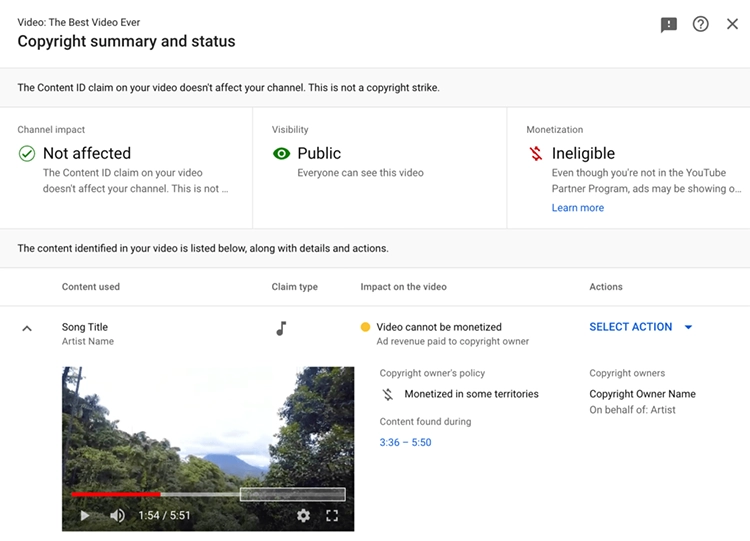
Remember, if your video receives a copyright claim on YouTube, it simply means that Content ID has identified copyrighted content (like a song or part of another person’s video) in your video that belongs to someone else.
Once that content is identified and the claim is placed, the copyright owner decides what happens next. In most cases, this doesn’t result in a channel penalty or strike, but it can affect your video’s visibility or monetization. Here are the most common actions a copyright owner might take.
🎯 What the Copyright Owner Can Do:
- Monetize your video: Ads may run on your video, and the copyright owner will receive the revenue.
- Track your video’s performance: The copyright owner allows your video to stay up, but they will track the video’s performance and analytics.
- Block your video: In some cases, your video might be blocked entirely or in certain countries.
- Mute the audio: The copyrighted audio could be removed from or muted in your video.
The most common scenario is that the copyright owner decides to monetize your video. This means that you, as the video uploader, can no longer monetize the video yourself. And because you don’t have the permissions or license to use the copyrighted song or content, that’s a pretty fair deal. Your video will still be viewable and your channel will remain in good standing on YouTube.
However, in extreme cases, the copyright owners may choose to remove your video completely with a takedown notice (or copyright strike), which you will read more about below.
⚠️ What a Copyright Claim Means for Your Video
If your video receives a copyright claim, this means that:
- You may not be able to monetize the video yourself.
- The only way to remove the claim is to:
- Dispute it (and provide evidence that you have a license to use the material)
- Replace or mute the copyrighted content (if it is an audio claim)
- Get permission or a proper license from the copyright owner
💡 Did you know? Sites like YouTube are required to provide copyright owners with copyright removal tools (like takedowns) in order to comply with copyright law.
Is a Copyright Claim the Same as a Copyright Strike on YouTube?
No, a copyright claim is not the same as a copyright strike. Understanding the distinction is crucial for managing your YouTube channel effectively and avoiding unnecessary worry.
🧐 How is a copyright claim different from a strike?
A copyright claim mean that copyrighted work was detected in your video and the copyright owner has decided to either monetize, track, or block your video. It is not a strike or penalty on your entire YouTube channel.
Copyright strikes result from official legal takedown requests on YouTube. When a video receives a copyright strike, it means that the copyright owner detected their copyrighted work in your video and issued a formal takedown notice with YouTube. A copyright strike results in your video being removed from YouTube completely and a strike being put on your YouTube channel.
💡 Key Differences: Copyright Claim vs. Copyright Strike
| ✅ Copyright Claim | ❌ Copyright Strike | |
| How the claim is made | Automatically by YouTube’s Content ID system or by a manual claim | Manually filed by the copyright owner |
| Legal status | Not a legal complaint | Official DMCA takedown request |
| Impact on video | Video may be monetized, tracked, or blocked in some regions | Video is removed from YouTube |
| Impact on channel | No strike; the claim doesn’t affect your channel standing | Strike added to your channel; may lead to feature loss |
| Impact on monetization | Uploader can not monetize. Revenue goes to the copyright owner if they apply a monetization claim | No monetization – video is taken down |
| How to fix | Dispute the claim, mute/replace content, or get a license | Wait 90 days, request retraction, or submit a counter-notification |
| Risk of channel termination | None | 3 strikes = channel termination 🚨 |
💡 Did you know? If you receive three copyright strikes, your entire channel and all videos may be permanently removed. You could also lose the ability to create new YouTube channels. For detailed information on copyright strikes, refer to YouTube’s official Copyright Strike Basics.
What are music copyright claims?
A music copyright claim happens when a video you upload to YouTube includes a song (or even just a part of a song) that is owned by someone else.
Music is one of the most common causes of copyright claims on YouTube. Why? Because songs often appear in video intros, as background tracks, during transitions, and in other creative edits to help elevate a video’s quality and make the content come alive.
As we’ve mentioned, the Content ID system scans every single video uploaded to YouTube video for copyrighted material, including music. If a match for copyrighted content is found, a copyright claim is automatically issued on behalf of the music’s owner.
🎵 Who owns a song or music copyright?
Every song has a least one owner, but more often, multiple owners. First, there are the individuals who wrote the song and control the music composition (the people who wrote the lyrics as well as the track itself). Then there are the people who own the recording of the song (this is called the master or sound recording) – these are typically record labels or the artist themself.
Here’s a quick overview of the two types of copyrights that every song has:
| Type of Copyright | Who Owns It | What It Covers |
| Composition | Songwriters, publishers | Lyrics and melody (the written song) |
| Master recording | Artist, producer, label, distributor | The audio recording of the song |
Here’s an easy way to visualize the different components of how music copyright is layered:
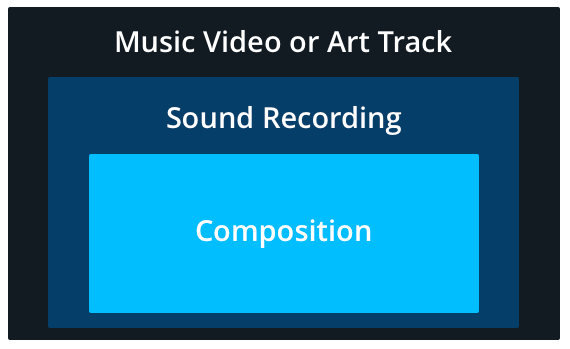
Every music video combines two main elements: the visual footage and the music, which includes the sound recording.
Within that sound recording is the composition (the underlying song itself). While each music video features one specific sound recording, that same recording can appear in multiple videos.
Similarly, each song has one composition, but that composition can be recorded in many different ways, such as through cover versions or alternate recordings of the same lyrics.
🎤 Let’s look at some examples of how music copyrights work:
Imagine tat Joe and Emma write a song together called “Triangle.” This means that:
- Emma & Joe share the composition rights (for the lyrics + melody).
- Emma records the track in a studio with her own money. She owns the master recording, aka the sound recording.
Later, Emma decides to sign a deal with a record label and her new songs are under her label deal. She and Joe get together to write a new song called “Square.” Under her deal with the label, this means that:
- Joe and Emma still share the song’s composition rights.
- The label owns the master recording because they funded the song’s production, mastering, and distribution (Note: label deal terms vary from label to label and artist to artist, but this example is the most common scenario).
Alternatively, instead of signing with a record label, Emma could release music independently through a music distributor like DistroKid, TuneCore, or CD Baby. In this case:
- The composition rights are shared by the writers of the song (Emma and Joe)
- Emma keeps ownership of the master recording.
- The distributor administers the sound recording and may issue Content ID claims to protect it on YouTube. They do not take any ownership of the song’s copyright.
⚠️ Why You Might Get a Music Copyright Claim
If your video contains copyrighted music (whether it’s playing as your video’s background music or for just a few seconds during your video intro), your video will be at risk of receiving a copyright claim.
Most music claims come from:
- Record labels (such as: UMG, Sony, Warner)
- Music distributors (such as: DistroKid, TuneCore, or FUGA)
- Rights management platforms acting on behalf of artists
✅ Pro Tip: To avoid music copyright claims, use songs that are properly licensed. Thematic offers claim-free music curated for creators (no takedowns, no stress 🎶).
How Copyright Claims Impact Your Channel and Videos
Understanding how copyright claims affect your YouTube presence is key to managing your content effectively. While claims don’t directly harm your channel’s overall standing, they can influence your videos’ monetization, visibility, and audience engagement.
In this section, we’ll break down the specific ways copyright claims may affect your channel and what you can expect when a claim occurs.
Should I worry about copyright claims?
Not necessarily. While copyright claims can feel worrying at first (especially when you get that email from YouTube), it’s important to understand what they actually mean for your videos and your YouTube channel in general
If your YouTube video includes copyrighted material ( that you don’t have permission to use (like music or video clips you don’t have permission to use), it’s perfectly normal to get a copyright claim. Remember, a claim is not a penalty on your entire channel – it is simply a way for the copyright owner to protect their copyrighted work.
That being said, copyright claims can impact your video’s performance. They may affect monetization, limit views, or reduce watch time. With that in mind, let’s explore how copyright claims can influence your videos and channel, and what you can do about it.
💡 Do Copyright Claims Affect My Channel?
No, a copyright claim does not harm your channel status or result in a strike. The claim applies only to the specific video where the copyrighted content was detected.
When your video receives a copyright claims, this means:
- Your channel remains in good standing with YouTube (even if you receive multiple claims on one video or claims across several different videos).
- You can still be part of the YouTube Partner Program. While you may not be able to monetize the specific video with the copyright claim, it does not impact your eligibility for monetization on YouTube in general.
- Your videos will still be discoverable on YouTube and will not be demoted in YouTube’s algorithms for search & discovery.
📌 Think of a copyright claim as a flag on a single video, not a penalty against your entire channel.
💰 Do Copyright Claims Affect Monetization?
Yes, when your video receives a copyright claim, you lose the ability to monetize that specific video.
YouTube requires that you own (or have licenses for) all of the content featured in your videos. So when your video receives a copyright claim, you can no longer monetize that video.
When a copyright claim is placed:
- The copyright owner can monetize your video by placing ads on it.
- You won’t receive any ad revenue from that video.
📌 Even a few seconds of copyrighted music can trigger a copyright claim and shift ad revenue to the rights holder, regardless of how original the rest of your video is.
📉 Do Copyright Claims Affect Views?
Yes, copyright claims can negatively impact your views, especially if your video is blocked in certain regions, on specific devices, or on third-party websites.
When a video receives a copyright claim, the copyright owner can choose to:
- Restrict playback on mobile devices or embedded websites
- Block your video in certain countries
If your audience is located in any of the blocked territories, or if you rely on views from editorial blogs or embedded players, you may see a noticeable drop in views.
⏱️ Do Copyright Claims Affect Watch Time?
Yes, copyright claims may indirectly affect the watch time of your channel.
If a claim causes your video to be blocked in certain territories or on certain devices, the number of viewers and watch time can decrease as a result. Fewer views naturally means less watch time.
Keep in mind:
- The watch time you do get still counts toward your channel’s total watch time.
- A copyright claim does not disqualify your watch time for monetization eligibility.
✅ TL;DR Impact of Copyright Claims
| Impact Area | Does a Copyright Claim Affect It? |
| Channel status | ❌ No |
| Monetization | ✅ Yes – you lose ad revenue |
| Video views | ⚠️ Possibly – if region/device restrictions are applied |
| Watch time | ⚠️ Possibly – indirect result of reduced availability |
🎶 Avoid claims with licensed music from platforms like Thematic that are built for creators and safe for YouTube.
How to fix a copyright claim on YouTube
If your video received a copyright claim, don’t panic. There are several ways to resolve the claim, depending on the situation.
🔍 Start by reviewing the details of the claim to see what content was flagged for copyright. Then, identify which of the following scenarios best fits your video.
If none of the options apply and you don’t have permission to use the claimed content, your best course of action might be to accept the claim or remove the video and re-upload it using properly cleared content.
👉 Learn how to prevent future music claims
✅ You Have a License or Permission
If you have permission to use the copyrighted content (such as a music license), you can dispute the claim.
This situation can be especially frustrating since you’ve done the work upfront to get the proper rights, only to have your video flagged anyway. What’s likely happening is that the copyright owner’s Content ID system automatically detected the copyright content in your video and flagged it without recognizing your license.
Here’s what to do:
- Submit a dispute through YouTube Studio (see instructions below).
- In your dispute explanation, clearly reference your license or permission agreement.
- Reach out to the platform, label, distributor, sync service, or copyright owner who granted your license to inform them of the dispute.
If everything goes smoothly, the claim will be released, and monetization on your video will be restored. Any revenue earned during the dispute process will be paid out to you once the claim is released.
✅ Pro Tip: Many music licenses cover only a single use. If you’re uploading the same track again, double-check whether your license allows for multiple uploads or uses.any licenses are single-use only. If this is your second upload using the same track, check if your license covers it.
🚩 You Received a False Copyright Claim
If the claimed content doesn’t actually appear in your video, it may be a false or abusive claim and you should dispute it.
For example, if you created and own 100% of the audio in your video, but receive a claim for a song that’s not present at all, that’s likely a mistaken or fake claim. In this case, the copyright owner has no grounds to claim your content.
How to handle it:
- Go to YouTube Studio and review the Copyright notice to check the timestamps and details of the claimed content.
- If the content being claimed isn’t in your video, file a dispute and clearly explain that the claim is invalid.
- Be direct: state that the claimed material does not exist in your video and provide context (such as: you created all the content yourself or used royalty-free assets).
Yes, this can be frustrating, but it’s fixable. False claims do happen, and YouTube gives you the tools to challenge them. Your video may have been a victim of Content ID abuse and your video should not have been claimed. Period.
✅ Pro Tip: YouTube shows exact timestamps for claimed content. Double-check this info to confirm whether the claim is accurate (or clearly false).
⚖️ Your Video May Qualify as Fair Use
If you’ve used copyrighted material for purposes like commentary, education, criticism, or parody, your video may fall under Fair Use.
Fair Use is a legal principle that allows limited use of copyrighted content without permission. However, it’s a complex area of law that depends on context, and it’s not always easy to determine what qualifies.
Helpful resources to better understand Fair Use:
- YouTube’s Guide to Fair Use
- Interactive Fair Use Checklist (The Ohio State University’s Health Sciences Library)
- Printable Fair Use Checklist (Columbia University Libraries’ Copyright Advisory Office)
⚠️ Note: This is not legal advice. If you’re unsure whether your video qualifies as Fair Use, it’s best to consult a legal professional.
🎵 Replace, Erase, or Mute the Song (Audio Claims Only)
If your video received a copyright claim for music, YouTube may give you tools to resolve the claim without removing the entire video. These options let you edit the claimed audio directly within YouTube Studio.
Here are the available options in YouTube Studio:
- Replace the song. Swap the claimed track with a free song from YouTube’s Audio Library (Note: you will not be able to select a song from your computer).
- Mute the song. This mutes all audio in the claimed section (including voice or ambient sound). This is usually a last resort if other options don’t work.
- Trim out the claimed segment. This cuts out the claimed section from your video entirely (both the video and audio).
- Erase song (beta). Removes just the music while keeping other audio like dialogue or sound effects. This works best if the music is isolated and not mixed with other sounds.
If you go with any of these options, the copyright claim will be removed, and your video may become eligible for monetization again, depending on your channel’s status.
How to dispute a copyright claim on YouTube
If you believe a copyright claim is incorrect, or if you have permission to use the content, you can file a dispute directly in your YouTube Studio dashboard.
Step-by-Step Details on how to dispute a YouTube copyright claim:
- Go to YouTube Studio
- Click Content in the left side menu
- Find the video with the copyright claim
- In the Restrictions column, click Copyright then See Details
- Click Take Action
- Select Dispute and follow the prompts to file your dispute.
You will find all of the information about the copyright claim specifics on this Copyright pop-up. Here you will be able to see:
- What content is being claimed
- Who issued the claim
- How the claim affects your video’s monetization and visibility
- The exact timestamps where the claimed content appears
✅ Pro Tip: Be specific in your dispute. Include proof such as a license agreement, original creation evidence, or a clear explanation of fair use. The more precise you are, the better your chances of a successful outcome.
How to Avoid Copyright Claims
The best way to prevent and avoid copyright claims entirely is by using only content you own or have the proper licenses for. Understanding how copyright claims work is the first step – once you know the basics, you can take practical steps to protect your videos and keep your channel running smoothly without interruptions from claims or lost monetization.
❌ Does Giving Credit Prevent Copyright Issues?
No. Simply giving credit in your video description does not protect you from copyright claims or legal consequences.
Even if an artist says “you can use my song,” it’s not valid unless:
- They own 100% of the song copyrights (both the composition and master), and
- You have a written license from them (or their label, manager, or rights holder)
💡 Reminder: Most songs have multiple copyright owners (including songwriters, producers, publishers, and labels). You need permission from all of them to legally use the copyrighted song in your videos.
🎯 What Is a Sync License (and Why Do You Need One)?
To use music legally in your YouTube videos, you need what’s called a synchronization license (or sync license). This contract gives you permission to “sync” a song with visuals (like your video).
A sync license includes:
- The specific song and how you’re using it
- Who owns the rights
- Terms of use (what you can do, where it can appear)
- What you’re offering in return (e.g., a fee or promotional credit)
Here’s a link to a sample sync license for reference.
But here’s the catch: Getting a sync license manually is complex, time-consuming, and often very expensive. You may need to:
- Contact multiple copyright holders
- Negotiate terms
- Draft and sign legal agreements
- Wait weeks (or longer) for approval
Only after all of that can you confidently upload your video without risking a copyright claim.
“This whole license process sounds like a lot of work.”
Yeah, it is. We’ve see the painful back-and-forths, the endless email threads with managers and artists and labels and publishers, the expensive license fees required by companies, the claims on videos even though you have permission, and… it’s pretty terrible, if we’re being honest here.
That’s why platforms like Thematic exist – to make this process easy for creators. Platforms like Thematic handle the sync licensing for you and offer pre-cleared music for creators, reducing your risk of copyright claims.
✅ The Easiest Way to Avoid Music Copyright Claims: Use Thematic
At Thematic, we’ve made finding music for YouTube videos simple, safe, and free for creators. Thematic offers an entire selection of trending and copyright safe music for creators to use in their videos for free.
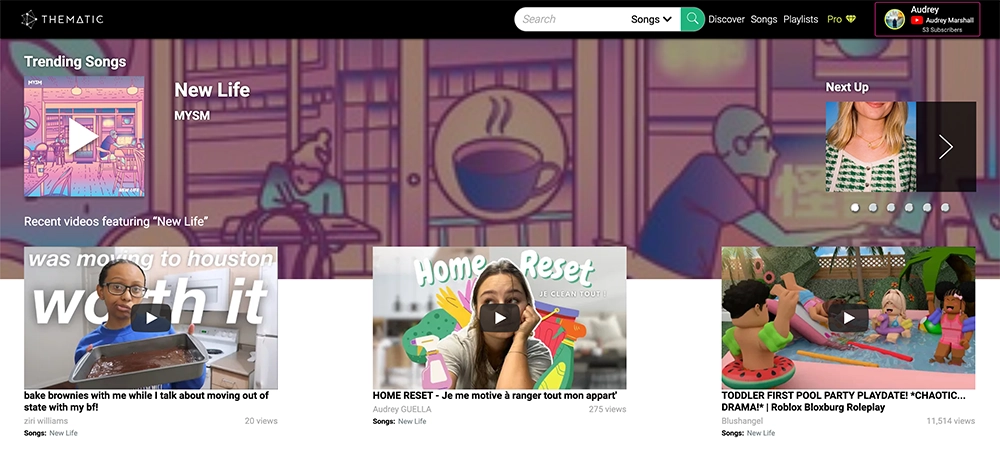
With Thematic, you get:
- 🎵 Access to high-quality music from emerging and trending artists
- ✅ Full protection from copyright claims and strikes
- ⚡ A smooth, claim-free workflow (no paperwork, no legal hassle)
It’s simple, because Thematic handles all of the sync licensing for you. You don’t have to worry about tracking down and emailing back and forth with the copyright owners (sometimes also called copyright holders). We think you should be spending your time creating and sharing great content, not drowning in paperwork.
It’s safe, because you will not be claimed for using the music. Seriously. With Thematic, your videos remain claim-free and copyright-free so long as you include the provided artist promotion in your video description.
And, it’s free. We don’t believe in charging creators antiquated, expensive rates just to use 45 seconds of a song in their video. You’re getting the word out and helping provide exposure and reach to artists who are looking for just that.
With Thematic, you get to use a wide selection of songs from the best new music artists. And you no longer have to worry about copyright claims, disputes, or strikes against your videos.
Other Claim-Free Music Options
If Thematic’s not your style, you can also explore:
- Public domain music: Music that is no longer under copyright protection and can be used freely
- Creative Commons music: Music shared by artists who allow reuse under certain conditions (usually requiring attribution)
- Music from YouTube Audio Library: A collection of royalty free production music that are copyright-safe for video creators
⚠️ Always check the specific license terms! Some CC tracks restrict commercial use or require linking back to the creator.
Ready to Use Music Without the Risk?
If you want to use music in your videos without worrying about copyright claims, strikes, or takedowns… Join Thematic to access a library of claim-free, creator-friendly tracks.
Looking for more creator tools and resources? Visit Thematic’s Creator Toolkit for additional resources on creating content – including starting a YouTube channel, thumbnail and channel art templates, best practices, and of course, great royalty free songs to use in your videos for free with Thematic.

This post on How to Fix Copyright Claims: The Ultimate Guide is brought to you by Thematic Co-Founder & COO Audrey Marshall
With a background in entertainment PR (via Chapman University), Audrey has led digital strategy for music artists, content creators, and brands. From brand campaigns for Macy’s, American Cancer Society, and the L’Oréal luxe family of brands, to music-driven influencer marketing campaigns for Interscope Records, Warner Music, AWAL, and Taboo of the Black Eyed Peas (featuring creators such as Lexy Panterra, Blogilates, Mandy Jiroux, Matt Steffanina, and Seán Garnier), she is an expert in navigating the influencer marketing space. Audrey has also developed and managed some of the leading beauty, lifestyle, and dance channels on YouTube.
Certified across the board with YouTube, Audrey has a specific focus on digital rights management for music assets, running multiple SRAV-enabled CMS. She is passionate about working with other builders in the space for a more transparent digital rights ecosystem.
At Thematic, Audrey leads the product team and oversees operations. She has driven partnerships with leading talent and music companies, including Songtrust, Kobalt/AWAL, Select Management, BBTV, ipsy, and Black Box, and has helped the platform grow to a thriving community of 1M+ content creators who have posted 1.6M+ videos using the platform, driving 60B+ music streams and $120M+ in earned media value for independent music artists.

